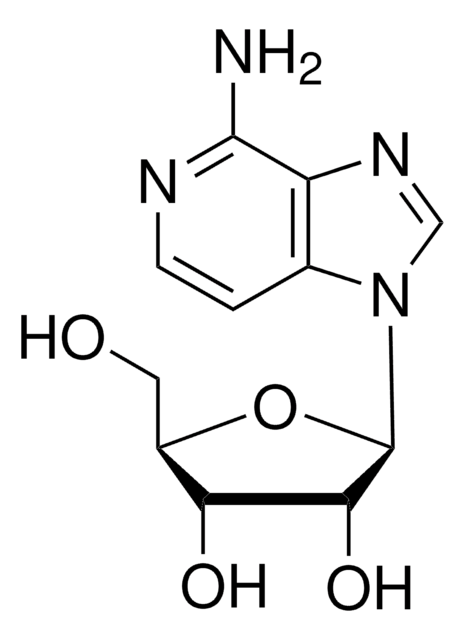T0642
Tubercidin
from Streptomyces tubercidicus, ~95%
Synonym(s):
7-Deazaadenosine
About This Item
Recommended Products
biological source
Streptomyces tubercidicus
Quality Level
Assay
~95%
form
powder
color
off-white
antibiotic activity spectrum
fungi
parasites
viruses
Mode of action
DNA synthesis | interferes
SMILES string
O[C@H]1[C@@H](O)[C@H](N2C=CC3=C2N=CN=C3N)O[C@@H]1CO
InChI
1S/C11H14N4O4/c12-9-5-1-2-15(10(5)14-4-13-9)11-8(18)7(17)6(3-16)19-11/h1-2,4,6-8,11,16-18H,3H2,(H2,12,13,14)/t6-,7-,8-,11-/m1/s1
InChI key
HDZZVAMISRMYHH-KCGFPETGSA-N
Gene Information
rat ... Adora1(29290)
Looking for similar products? Visit Product Comparison Guide
Related Categories
General description
Application
Biochem/physiol Actions
Other Notes
Signal Word
Danger
Hazard Statements
Precautionary Statements
Hazard Classifications
Acute Tox. 2 Oral
Storage Class Code
6.1A - Combustible acute toxic Cat. 1 and 2 / very toxic hazardous materials
WGK
WGK 3
Flash Point(F)
Not applicable
Flash Point(C)
Not applicable
Personal Protective Equipment
Certificates of Analysis (COA)
Search for Certificates of Analysis (COA) by entering the products Lot/Batch Number. Lot and Batch Numbers can be found on a product’s label following the words ‘Lot’ or ‘Batch’.
Already Own This Product?
Find documentation for the products that you have recently purchased in the Document Library.
Customers Also Viewed
Our team of scientists has experience in all areas of research including Life Science, Material Science, Chemical Synthesis, Chromatography, Analytical and many others.
Contact Technical Service











